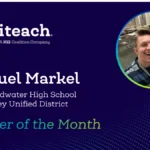What Is T-TESS?
The Texas Teacher Evaluation and Support System process was developed by the Texas Education Agency or TEA and includes standards for professional development goal setting. To write T-TESS goals, having a holistic view of areas of improvement and a vision for career development is essential.
Texas teachers prepare a Goal-Setting and Professional Development (GSPD) Plan including detailed professional goals. The development of a GSPD Plan that includes specific, measurable goals, necessary action steps, and desired outcomes that promote the professional development of educators.
A well-developed plan begins with honest self-assessment, identifying areas of desired improvement, defining personal development milestones, and breaking goals down into actionable steps.
With a clear idea of what you want to achieve, writing T-TESS goals becomes simple and formulaic. Each T-TESS goal has four elements: The goal and dimension or dimensions, specific actionable steps, a targeted completion date, and evidence of goal attainment.
Breaking down each of these elements with examples will make it easy for you to define your own specific and measurable goals.
Writing T-TESS Goals
Let’s dive into the four elements of a T-TESS goal.
Goal and Dimension
T-TESS goals are desired outcomes that address specific areas of improvement across 16 dimensions. These dimensions ensure that goals have a broad impact on teaching practices. To write clear, specific goals, identify and target dimensions with clear opportunities for improvement.
Goals should align with the Texas Teacher Standards, connect with student outcomes, and be geared toward continuous improvement. Texas teachers are assessed across 16 dimensions within the T-TESS process. Targeting multiple domains with each goal ensures outcomes have the widest impact on teaching practices.
For example, suppose feedback and self-assessment have identified an opportunity to improve the classroom environment. In that case, you may set a goal to create a visually stimulating and organized classroom environment that promotes student engagement and a positive learning atmosphere.
To improve communication, you may set a goal to establish regular communication channels with parents, such as newsletters, emails, or a class website, to keep them informed about classroom activities and student progress.
Actions
Actions describe the specific steps required to meet each goal. By breaking goals down into actionable steps during the goal-setting process, you create a checklist for success. Actions should align with standards and directly impact desired outcomes. Planning for and executing these actions helps create documentation and evidence to assess goal achievement.
An example of a classroom environment action might be to rearrange classroom furniture to create designated areas for different activities, ensuring an optimal flow for instruction and student movement. Actions that address communication include creating a monthly newsletter to keep parents informed.
Include collaborative details, including frequency and purpose of meetings, colleagues, departments and organizations involved, and specific classroom practices in your actions. Every T-TESS goal should include how you intend to reach your desired outcome.
Targeted Completion Date
Determining a deadline for T-TESS goals adds a layer of accountability and helps you define your priorities. Completion dates also make it easy to track progress, set milestones, and assess the efficacy of action plans between assessments.
Like your goals, completion dates should be ambitious but realistic. To choose a targeted completion date, assess the scope of the goal and necessary actions. Establish a timeline of specific goal milestones and estimate the completion date. Including a timeframe at the beginning or end of your goal helps this critical detail stand out.
Evidence of Goal Attainment
For T-TESS assessments, evidence can include teacher self-assessments, classroom observations, student success, and more. Evidence and documentation are a crucial component of the T-TESS assessment process providing accountability and valuable insight. Include specific assessment and evaluation processes, quantified successful outcomes, and requisites for success in each goal.
Reflective journaling, lesson plans, meeting notes, student success data, and reports are essential to illustrate the success of your T-TESS goals. Organizing evidence and documentation should be an ongoing process throughout your teaching process and will make preparing for assessments easier.
How to Set T-TESS Goals
There are a few things to keep in mind when writing your T-TESS goals.
Be Specific and Realistic
Unrealistic goals can become overwhelming and discouraging. By balancing realism and ambition, Texas teachers can set attainable but challenging goals that encourage professional development without demoralization. T-TESS goals should be challenging and engaging not intimidating.
Utilize feedback to highlight opportunities for improvement and prioritize specific areas for growth. Align your goals with key aspects of effective teaching by targeting the four T-TESS domains. Goals should illustrate connections between professional development outcomes and student success. A specific goal not only defines the objective, but also the impact that outcome will have on teachers, students, and school communities.
Goals that include direct language from the T-TESS domains, dimensions, and rubric are straightforward to assess. Including target numbers like frequency and percentages in goals provides high-value detail, making goals objectively simple to measure.
Aim for Excellence
While remaining realistic and achievable, T-TESS goals should be ambitious and challenge teachers to exceed baseline expectations. Within a continuous improvement model, teachers are encouraged to participate in an ongoing cycle of reflection, action, and refinement that fosters professional development. Pushing out of comfort zones, taking risks, and innovation are the hallmarks of an ambitious goal.
Goals designed to exceed expectations while remaining attainable must be thoughtfully designed. Targeting individual talents and interests makes an ambitious goal more engaging and easier to achieve. Excellence requires going above and beyond. By designing goals that leverage their strongest skills for professional development, educators maximize the likelihood of success. The advantage of honest self-assessment and individual goal setting is subject matter expertise.
The overarching goal of the T-TESS evaluation process is to establish a growth mindset and create a culture of perpetual improvement. Choosing ambitious goals fosters these goals as much as professional development at the individual level.
Make It Measurable
Defining goals using specific metrics, such as percentages, numerical targets, or other quantifiable measures ensures that progress can be objectively tracked. T-TESS goals should include observable performance indicators and milestones that demonstrate the efficacy of action steps toward desired outcomes.
Include observable outcomes when writing goals to communicate not only what you hope to achieve but also how others can assess the success of the goal.
What should the outcome of the goal be? Don’t stop at defining a goal for an increase in a named skill. Define what percent increase and how the skill will be assessed. Consider markers of success for classroom observers, students, and yourself.
T-TESS Goal Examples
Elementary
Elementary students are still building foundational skills and teaching goals should reflect the unique needs at this stage of development. Goals that promote professional growth, improved instructional practices, and a positive learning environment are perfect for elementary teachers.
Example Goals
- Ensure 90% of reading lesson plans emphasize phonics instruction and targeted vocabulary development, as evidenced by lesson plan reviews.
- Implement differentiated instruction in 80% of math lessons to increase student mastery of foundational math concepts. Measure progress through assessment data aiming for a 15% increase in students who meet or exceed grade-level expectations by the end of the semester.
- Create a positive and organized classroom environment with enhanced classroom management practices. Implement positive behavior reinforcement, verbal praise, and tangible rewards, from weekly to twice weekly, and record with reflective journaling.
Secondary
For older students, write goals that address subject expertise, differentiated instruction, and assessment strategies, and reflect the diverse demands and individual developmental stages of secondary education. The examples below align with the needs of students and teachers with strong foundational skills.
Example Goals:
- Increase subject expertise by incorporating real-world applications of current research into lesson plans. Review lesson plans to ensure that 90% of lessons include content aligned with the latest research and advancements.
- Apply differentiated instruction strategies in 80% of lessons in mixed-ability classrooms. Tailor instruction based on student readiness assessments. Measure progress through student performance assessments, aiming for a 10% increase in subject matter mastery.
- Integrate digital tools and resources into 80% of lessons to increase subject matter expertise in the use of technology. Assess effectiveness through student surveys and classroom observations.
Special Education
Special education is a unique landscape requiring highly individualized goals. Setting T-TESS goals that pertain to the development and implementation of individualized education plans (IEPs), effective use of assistive technology, and collaboration with colleagues like the examples below include a desired outcome, actionable steps, and markers of success while addressing specific dimensions:
Example Goals:
- Enhance the development and implementation of Individualized Education Plans (IEPs) by conducting quarterly progress monitoring meetings with the IEP team. Ensure that all IEP goals are specific, measurable, attainable, relevant, and time-bound (SMART). Measure progress through documentation of goal achievement and student outcomes.
- Deepen collaboration with general education partners to promote inclusion of students with special needs in mainstream classrooms. Engage in regular co-teaching and co-planning in 70% of lessons. Measure progress through student performance data and direct observation.
- Integrate assistive technologies in 80% of lessons and assess impact through feedback and student performance. Implement professional development and skills training on the use of assistive technologies.
T-TESS Goals as a Tool for Professional Development
Defining your own challenging goals as part of the T-TESS process is an opportunity to take ownership of your professional development. By approaching goal setting with a growth mindset, an understanding of the aim of the T-TESS assessment program, and an organized plan, you can write a roadmap for your success while improving the quality of education for Texas students.
The process of writing T-TESS goals is straightforward when you break each goal, define each element of the goal, and include specific, measurable details.





